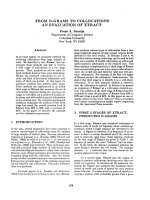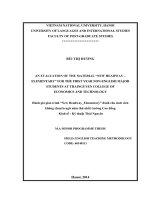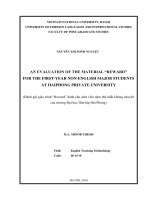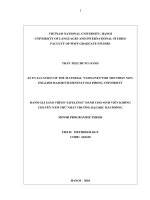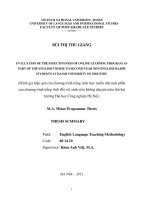An evaluation of general English course from non-English major students’ learning needs analysis
Bạn đang xem bản rút gọn của tài liệu. Xem và tải ngay bản đầy đủ của tài liệu tại đây (705.58 KB, 11 trang )
<span class='text_page_counter'>(1)</span><div class='page_container' data-page=1>
<i>DOI: 10.22144/ctu.jen.2018.008 </i>
<b>An evaluation of general English course from non-English major students’ learning </b>
<b>needs analysis </b>
Doan Thi Loan1<sub> and Thai Cong Dan</sub><b>2* </b>
<i>1<b><sub>The Southern Transport College, Vietnam </sub></b></i>
<i>2<sub>School of Foreign Languages,</sub><b><sub>Can Tho University, Vietnam </sub></b></i>
<i>*Correspondence: Thai Cong Dan (email: ) </i>
<b>Article info. </b> <b> ABSTRACT </b>
<i>Received 09 Jun 2017 </i>
<i>Revised 06 Oct 2017 </i>
<i>Accepted 30 Mar 2018</i>
<i><b> This paper is aimed to evaluate general English course (GEC) at the </b></i>
<i>South-ern Transport College (STC) from analyzing learning needs of non-English </i>
<i>major students to improve the quality of the course, meet students’ learning </i>
<i>needs, and the national criteria of curriculum design. The non-English </i>
<i>ma-jor students' learning needs are defined as encompassing students' </i>
<i>reac-tions to GEC, language input, language skills, use of knowledge, teachers </i>
<i>and teaching methods, testing and assessment, and learning outcome. </i>
<i>Since the needs analysis and course evaluation were complex tasks with </i>
<i>various possibilities of the needs, interviews of students and teachers were </i>
<i>conducted to collect qualitative data purposing to strengthen the </i>
<i>quantita-tive data from two questionnaires. The two questionnaires on students </i>
<i>learning needs and their evaluation of GEC were adapted from the original </i>
<i>version of Stufflebeam’s (1983) CIPP evaluation model or Context, Input, </i>
<i>Process, Product approach and Sarah Cook’s (2005) ADDE model - </i>
<i>Anal-ysis, Design, Delivery, Evaluation model - in Likert scales. The questions </i>
<i>for interviewing students and teachers were adopted from interview </i>
<i>ques-tions in Mahmoud’s (2014) study. The data were analyzed to answer the </i>
<i>two research questions: (1) What are non-English major students learning </i>
<i>needs? (2) To what extent does general English course satisfy students’ </i>
<i>learning needs? One hundred forty-eight students and four teachers got </i>
<i>involved in the study as participants. The findings revealed that students at </i>
<i>STC were most interested in knowledge and language input provided from </i>
<i>GEC. It also revealed that the students preferred extracurricular activities, </i>
<i>watching videos or small group discussions in the language learning </i>
<i>pro-cess. From the students’ evaluation of GEC, it was seen that their learning </i>
<i>needs were different from the actual course they received. The students </i>
<i>fairly agreed with teachers and teaching methods, testing and assessment, </i>
<i>but the actual course did not entirely satisfy students’ learning needs. </i>
<i>Im-plications for teachers and school administrators are provided. </i>
<i><b>Keywords </b></i>
<i>Evaluation, General English </i>
<i>course, learning needs, </i>
<i>non-English major students, </i>
<i>Southern Transport College </i>
<i>(STC) </i>
</div>
<span class='text_page_counter'>(2)</span><div class='page_container' data-page=2>
<b>1 INTRODUCTION </b>
In the context of education in Vietnam, English is a
compulsory subject to Vietnamese students from
primary schools to universities. Non-English major
students (EFL) would like to learn English because
they had more functional or external needs, such as
the need to pass examinations, or for possibly,
career opportunities. Therefore, EFL students’
learning needs analysis is an essential step in foreign
language curriculum design and course evaluation
for EFL students in non-native English speaking
countries. This study is conducted as an EFL
students’ learning needs analysis in order to
evaluate general English Course (GEC) at
elementary level (A2) at a college in the Mekong
Delta, with an expectation of finding out the
strengths and weaknesses of the curriculum to
ensure the course makers to decide whether the
curriculum should be revised, compared, continued
or completed (Ornstein & Hunkins, 1988).
It is believed that GEC provides foundational
English knowledge for academic study or social
communication to EFL students. However, EFL
students prefer studying reading and writing to
listening and speaking skills, therefore they often
face difficulties in practicing listening and speaking
in real communications. In addition, students cannot
use language contents in GEC for their academic
study after finishing GEC. Moreover, no evaluation
research of GEC conducted in the Mekong Delta
was found. Understanding this gap in the literature
of English course evaluation, this study aims to: (1)
gain insight into EFL students’ learning needs in
taking GEC; (2) identify whether their actual
English course satisfies their learning needs or not;
(3) improve the quality of GEC to meet EFL
students’ leaning needs.
<b>2 REVIEW OF LITERATURE </b>
The term “evaluation” in language education has
been defined in a variety of ways. Many researchers
provided definitions of evaluation in relation to a
process and a product. For example, Brown (1989)
defined it as “the systematic collection and analysis
of all relevant information necessary to promote the
improvement of a curriculum, and assess its
effectiveness and efficiency, as well as the
participants' attitudes within a context of particular
institutions involved" (p.223). In contrast, Lynch
(1996) defined evaluation as “the systematic attempt
to gather information in order to make judgments or
decisions” (p.2). This definition was too broad since
it made no direct reference to evaluation as both a
process and a product. In recent years, however,
Jacobs (2000)
has maintained that EFL program evaluation is a
multidimensional process in which the political,
ideological, social and cultural aspects of program
components need to be critically investigated in
order to judge their relevance to learners’ needs in a
particular context.
According to Middlewood and Burton (2001),
evaluation in education is realized to define, clarify
and set criteria, and based on the criteria to find out
objective value, quality, benefit, performance and
importance of the evaluation. This emphasizes the
importance of program evaluation including
language policy, materials, curriculum,
administrators, students, teachers, methods and
external consultants, in order to determine the merit
or the achievement of a particular program (Lynch,
2003).
Several studies have shown that it is necessary to
understand and be aware of learners’ needs to
correspond to course design or specific contexts
(e.g., Hutchinson and Waters, 1987; Brindley, 1989;
Long, 2005; Nguyen, 2011; Nguyen and Nguyen,
2017). With Widdowson (1981), needs refers to the
present or future requirement of learners, and what
they expect to learn after they finish the language
course. Likely, Hutchinson and Waters (1987)
classified learners’ needs into two types such as
target needs (necessities, wants, and lacks), and
learning needs. Brindley (1989) stated that needs
may be equally to learners’ “wants” or “desires”
which refers to what the students themselves would
like to learn in addition to their program
requirements. Berwick (1989) defined “needs” as
“the gap between the current situation and the
anticipated future state” (p.52). According to Long
(2005), the determination of learner needs in foreign
language teaching is a prerequisite that becomes
increasingly more important for efficient course
design. Meanwhile, a study of Lüdtke and
Schwienhorst (2010) confirmed that a needs
analysis is seen as a beneficial tool for a language
centre that thinks strategically and seeks long-term
development.
</div>
<span class='text_page_counter'>(3)</span><div class='page_container' data-page=3>
systematically guide the conception,
design,implementation, and assessment of
service-learning projects, and provide feedback and
judgment of the project’s effectiveness for
continuous improvement.
In this research, Stufflebeam’s CIPP evaluation
model has been adapted. The reason why this model
has been chosen is that it is feasible in foreign
languages curricula and involves various evaluation
types in the current research including students'
reactions, language input, skills, knowledge,
teachers and teaching methods, testing and
assessment, and students’ learning outcome. The
findings from this study will help the teachers and
administrators revise the curriculum of GEC in
order to improve the quality of GEC and meet the
legitimate learning needs of students.
<b>3 RESEARCH QUESTIONS </b>
The study is to answer the two following questions:
1.What are non-English major students learning
needs?
2.To what extent does general English course satisfy
students’ learning needs?
<b>4 METHODOLOGY </b>
<b>4.1 Participants </b>
Participants were freshmen who were attending
two-year courses at the Southern Transport College
(STC) in the school year of 2016-2017. One hundred
and forty-five participants who were selected from
a total of 221 students in 4 classes responded to the
questionnaires. Seven students were chosen from
148 participants to join in the interviews. Four of
them were selected from the volunteers and the
others were appointed randomly by the researcher.
Most of the participants were male students whose
majors were in Civil Engineering, Mechanical
Engineering, Electrical Engineering, and Waterway
Accounting. Informants’ background knowledge
was overcoming examinations of English for
general purposes from lower and upper secondary
schools, and their English learning experiences were
around three to seven years. The participants’ ages
were from 18 to 30 years old. The type of education
<b>was fulltime students who attended class in daytime, </b>
and the GEC was taught as compulsory subject.
Besides, the researcher interviewed four EFL
teachers who have had experiences of general
English teaching at STC for 6-10 years. Teachers’
responses were considered as evidence to confirm
the information of students’ evaluation and seek
their own view of points about GEC as well.
<b>4.2 Instruments </b>
<i>4.2.1 Questionnaires </i>
The two survey questionnaires were used to collect
the quantitative data. They were adapted from the
original version of Stufflebeam’s CIPP evaluation
model (1983) and Sarah Cook’s the ADDE model
(2005), and followed the five-point Likert-scale
from a stronger endorsement to a weaker
endorsement of needs and satisfactory: (5) strongly
agree, (4) agree, (3) neutral, (2) disagree, and (1)
strongly disagree. Each survey questionnaire has 57
<b>items in order to measure the seven clusters: (1) </b>
students’ reactions, (2) language input, (3) language
skills, (4) use of knowledge, (5) teachers and
teaching methods, (6) testing and assessment, (7)
learning outcome. The clusters and items in the
questionnaires are described in Table 1.
<b>Table 1: Clusters and items in the questionnaires </b>
<b>Clusters </b> <b>Questionnair<sub>e items </sub></b> <b><sub>number </sub>Total </b>
1. Students’ reactions 1 - 6 6
2. Language input 7 - 16 10
3. Language skills 17 - 28 12
4. Use of knowledge 29 - 35 7
5. Teachers and teaching
methods 36 - 47 12
6. Testing and assessment 48 - 52 5
7. Learning outcome 53 - 57 5
Total: 57
Because the participants were students with low
level of English competence (approximated A1 to
A2), the questionnaires were designed in bilingual
versions to avoid misunderstanding with a desire to
obtain the most reliable data. The questionnaire on
students’ learning needs was piloted with 36
students who majored in Civil Engineering at The
Western Construction College in Can Tho. With the
questionnaire on students’ evaluation of GEC, 25
senior students majored in Mechanical Engineering
at STC were asked for their responses. The
reliability coefficients of the two questionnaires
were α = .787 and α = .902 respectively. These
figures have suggested that the questionnaires were
acceptable to be used for conducting research with a
larger number of participants.
<i>4.2.2 Interviews </i>
</div>
<span class='text_page_counter'>(4)</span><div class='page_container' data-page=4>
two formats: (1) multiple choices in which
respond-ents could select multiple items about which ones
satisfied their learning needs; (2) free discussions of
the items which did not satisfy their learning needs,
and they were asked to give suggestions to develop
the GEC in order to meet their learning needs.
Inter-view questions for EFL teachers were designed in
English version. EFL teachers’ evaluation of GEC
will help to strengthen the reliability and validity of
the data from students’ evaluation.
<b>4.3 Data analysis </b>
<i>4.3.1 Questionnaires </i>
The data collected from the survey were analyzed
by the software SPSS version 18.0. The raw data
<i>were statistically analyzed by the following tests: </i>
<i>Scale Test, Descriptive Statistics Test, One Samples </i>
<i>T-Test, Pair Samples T-Test to check the reliability </i>
of the questionnaires, find out the average level of
participants’ agreement with pre-questionnaire on
need and post-questionnaire on evaluation, see the
differences between the students’ learning needs
and their evaluation of the actual course, check the
mean score of each cluster in order to find out which
<i>one was evaluated higher. </i>
<i>4.3.2 Interviews </i>
The interviews were transcribed for analysis. To
an-alyze the interview data, an interview protocol was
employed with the following steps of analysis: (1)
develop a framework of themes for investigating
within an interview protocol; (2) analyze the
tran-scribed data and code the information relating to
themes investigated; (3) organize the theme data
coded into the interview protocol; (4) search for the
similarities and differences among students’
learn-ing needs and the actual general English course
which they took; (5) interpret the data from the
in-terview protocol; and (6) report the results.
<b>5 RESULTS AND DISCUSSSIONS </b>
<b>5.1 Results from quantitative data </b>
<i>5.1.1 Students’ reactions to General English </i>
<i>course </i>
In general, the students’ reactions to the actual GEC
were positive. The percentages of students’ learning
needs and their satisfaction of GEC were over 80%.
Forty-one percent of students agreed with QN.I6, it
means 59% of them confirmed that they learned
GEC not just because it was a compulsory subject,
they learned GEC because they liked studying
Eng-lish and they were “looking forward to studying”.
The result shows that participants’ satisfaction of
the actual English course was above average but
lower than their needs.
<i><b>Fig. 1: Students’ reactions to General English course </b></i>
<i>(Responses to pairs of items (1-1, 2-2, 3-4, 4-5, 5-3, 6-6) in QN and QE) </i>
<i>5.1.2 Language input </i>
The degree of the participants’ satisfaction of the
language input in Figure 2 was at very high values
in some aspects such as materials, learning topics,
daily life, and vocabulary. However, some items
like updated information, short reading texts,
listen-ing speed, interestlisten-ing practical exercises, and
pro-nunciation were not highly evaluated. The reasons
for these problems might be found out from the
in-formation of qualitative data. The results suggest
0%
10%
20%
30%
40%
50%
60%
70%
80%
90%
100% 93% 93% 96%
98% <sub>93%</sub>
41%
89%
82% 85% 86% 86%
55%
</div>
<span class='text_page_counter'>(5)</span><div class='page_container' data-page=5>
that educators, program designers and teachers
should make plans to improve the quality of these aspects in order to meet students’ learning needs and gain the highest result in the teaching process.
<i><b>Fig. 2: Language input </b></i>
<i><b>(Responses to pairs of items (7-7, 8-8, 9-9, 10-10, 11-11, 12-12, 13-13, 14-14, 15-15, 16-16) in QN and QE) </b></i>
<i>5.1.3 Language skills </i>
There were some differences between students’
learning needs and students’ satisfaction regarding
language skills. Most of the items in language skills
cluster of students’ learning needs scored over 80%
demonstrating that there is a desire to develop all
language skills through GEC. However, there are
only 55% of participants agreed that they have been
developed all four skills. To be more specific, the
degree of participants’ satisfaction of language
skills was different from one another (listening:
64%, reading: 50%, speaking: 52%, writing: 69%).
The students reflected that their language skills were
not improved as their desire at the beginning of the
course.
<i><b>Fig. 3: Language skills </b></i>
<i>(Responses to pairs of items (17-17, 18-18, 19-19, 20-20, 21-21, 22-22, 23-23, 24-24, 25-25, 26-26, 27-27, 28-28) in QN </i>
<i>and QE) </i>
<i>5.1.4 Use of knowledge </i>
Figure 4 showed a significant difference between
stu-dents’ learning needs and stustu-dents’ evaluation of
GEC. Participants’ satisfaction of knowledge
pro-vided from GEC was high in some aspects:
founda-tion knowledge, basic vocabulary, useful grammar
points, helpful to future job; however, the degree of
0%
10%
20%
30%
40%
50%
60%
70%
80%
90%
100% 97%
98% 99% <sub>97% 97% 99% 98% 99%</sub> 99%
26%
90% 99% 98%
78% 77%
62%
86% 99% 93% 92%
% learning needs
% satisfaction
0%
10%
20%
30%
40%
50%
60%
70%
80%
90%
100% 98%
5%
81%
94%
75%
93%
55%
93%
82%
94% <sub>88% 90%</sub>
55%
36% 39%
95%
82%
50% 52%
84% 90%
69% 77%
51%
</div>
<span class='text_page_counter'>(6)</span><div class='page_container' data-page=6>
their satisfaction was lower than average level in
daily communication because they could not answer the interviews as confidently and fluently as they had expected.
<i><b>Fig. 4: Use of knowledge </b></i>
<i>(Responses to pairs of items (29-29, 30-30, 31-31, 32-32, 33-33, 34-34, 35-35) in QN and QE) </i>
<i>5.1.5 Teachers and teaching methods </i>
In Figure 5, it can be seen that the participants highly
evaluated most of the items about teachers and
teaching methods. However, the items 36 and 41
had negative meaning, they were limitations of the
actual GEC because of no native English speakers
in class and no extracurricular activities during the
course. Comparing students’ learning needs and
their evaluation, it can be inferred that what they
have been supported was corresponding to their
learning needs. Teachers have been successful with
their teaching methods, they have combined four
skills (listening-reading-speaking-writing) in a
pe-riod to maximize the benefits and reduce the
limita-tions of each skill. The results of students’ and
teachers’ interviews will be reported in the
follow-ing part to supply more information about teachfollow-ing
methods.
<i><b>Fig. 5: Teachers and teaching methods </b></i>
<i>(Responses to pairs of items (36-37, 37-40, 38-36, 39-39, 40-41, 41-38, 42-42, 43-43, 44-44, 45-45, 46-46, 47-47) in QN </i>
<i>and QE) </i>
<i>5.1.6 Testing and assessment </i>
In Figure 6, it can be seen that the participants’
knowledge of testing and assessment was above the
average level. That means they have ability to
deter-mine the goals of formative and summative
assess-ments. They highly evaluated the actual English
0%
10%
20%
30%
40%
50%
60%
70%
80%
90%
100% 90% 97%
99% <sub>94%</sub> 99%
78%
96%
100%
78%
92%
49%
38%
62%
85%
% learning needs
% satisfaction
0%
10%
20%
30%
40%
50%
60%
70%
80%
90%
100%
72%
100%
80% 97%89% 99%93% 97%<sub>69%</sub>
96%
62%
95%
100%
87%100% <sub>86%</sub>100% 85% 82% 94%87% 85%87% 84%
</div>
<span class='text_page_counter'>(7)</span><div class='page_container' data-page=7>
course and evenly higher than their needs in some
items. They highly evaluated the appropriateness and validity of the tests, and the results of testing will present and discuss in the next part.
<i><b>Fig. 6: Testing and assessment </b></i>
<i><b>(Responses to pairs of items (48-48, 49-49, 50-50, 51-51, 52-52) in QN and QE) </b></i>
<i>5.1.7 Learning outcome </i>
The results, in Figure 7, showed that students
eval-uated the actual GEC lower than their learning needs
except item 55 (QE) “passing the final exam”
(83%). Only sixty-two percent of them thought that
their English competence was at level A2 and they
were willing to take the national examination of
level A2. The problem was that they highly
evalu-ated the appropriateness and validity of the tests, but
why 17% of them failed in the final exam. More
in-formation about their learning styles, knowledge,
and test taking will be reported and discussed in
qualitative data.
<i><b>Fig. 7: Learning outcome </b></i>
<i><b>(Responses to pairs of items (53-54, 54-53, 55-56, 56-57, 57-55) in QN and QE) </b></i>
<b>5.2 Results from qualitative data </b>
In addition to the results from quantitative
data, the qualitative data supply more profound
in-formation from the interviews of seven EFL
stu-dents and four EFL teachers. The stustu-dents’
inter-views aim to find out the reasons why the students
<b>were not satisfied with some aspects in the actual </b>
GEC and look forward to seeking more information
about their expectations of their English course. The
teachers’ interviews purposed to confirm the
infor-mation about students’ evaluation and seek their
own view of points about improving the quality of
0%
10%
20%
30%
40%
50%
60%
70%
80%
90%
100% <sub>79%</sub>
99% <sub>96%</sub>
89%
52%
95% <sub>93%</sub> 94% 100%
78%
% learning needs
% satisfaction
0%
20%
40%
60%
80%
100%
97% 100% <sub>95%</sub> 96%
66%
62%
93%
62%
92% 83%
</div>
<span class='text_page_counter'>(8)</span><div class='page_container' data-page=8>
GEC in order to meet students’ learning needs but
still keep the rules in the curriculum design as well.
<i>5.2.1 Students’ interviews </i>
Question 1: What were you satisfied with GEC?
Most of the participants were satisfied with topics in
the course book, contents of the topics, vocabulary,
teachers and teaching methods, and testing and
as-sessment. The items which they were not satisfied
with were grammar points, pronunciation, and
learning outcome.
Question 2: Why weren’t you satisfied with the
other(s)?
They were not satisfied with “grammar points”
be-cause there were not a lot of interesting practical
ex-ercises in class, and they did not have chance to
work in groups; therefore, they could not discuss to
find the answers exactly.
With “pronunciation”, five participants responded
that teachers did not concentrate on practicing
pro-nunciation for them in class. Some propro-nunciation
parts in the course book were not taught, so they
usually made mistakes in pronouncing the words.
However, the causes were not only from the
teach-ers but also from students themselves. In fact, many
non-English major students did not like studying
English, so they did not spend much time for doing
homework or practice English outside classrooms.
Five out of five students responded that they did not
<i>“practice pronouncing English through video clips </i>
<i>at home”. </i>
In general, the effectiveness of developing
pronun-ciation for students in GEC was not good because
there were no cooperation and effort from both
teachers and students in teaching and learning
pro-cess.
Three participants were not satisfied with “learning
<i>outcome” because they “didn’t go to class </i>
<i>regu-larly”. Therefore, they failed some skills in the GEC </i>
such as speaking and reading, and lacked test taking
skills.
Last but not least, EFL teachers did not have an
in-depth investment for improving all language skills
and knowledge of students. Secondly, the
partici-pants loved studying grammar rather than
pronunci-ation because they would like to have a lot of
inter-esting practical exercises in groups but they did not
spend time for practicing pronouncing English.
Question 3: What skill(s) have you been improved?
What most?
Most students agreed that their listening, reading,
speaking, writing skills and sub-skills (skimming,
making conversations, sending messages) have been
improved, but only one among seven students
thought that their sub-skills were improved most.
The skill that they thought was developed most was
listening skill.
Question 4: What skill(s) has not been improved?
Why not?
Five out of seven students responded that their
soft-skills have not been improved because there was not
much group work.
In comparison with the answers of the interview
question 2, students also complained they did not
have many chances to work in groups. As a result,
their soft-skills in group working such as
negotia-tion, discussion, meeting holding, presentation…,
which were not improved much through GEC.
From the results of students’ interviews, it can be
concluded that teachers did not create an effective
learning environment to enable students to develop
their speaking, writing, and soft-skills.
Question 5: If there is a national examination of
level A2 organized at school, will you register?
Five over seven students said: “No”. There were two
reasons for this problem. First, they were not
confi-dent enough to take the national exam, and they
thought they needed more time to review their skills
and knowledge. The second reason was that they
just needed overcome the final exam. It is easy to
explain for this reason because the interviewees fail
in the final exam. Therefore, their immediate goal is
passing the exam. However, the major goal of
ad-ministrators at STC is to give students chances to
gain the certificate of level A2 so that they will get
certain benefits for their future job application.
<i>5.2.2 Teachers’ interviews </i>
Question 1: Have you ever used any supplemental
teaching materials? What skills for?
</div>
<span class='text_page_counter'>(9)</span><div class='page_container' data-page=9>
Question 2: What skills of students have been
im-proved through GEC? What has not much?
The teachers shared the same view of point which
students have been improved listening skills. Three
over four teachers confirmed that their students have
been improved both listening and speaking skills.
Students’ writing skill has not been improved much
because they might be lazy or did not like practicing
writing at home.
Question 3: Which methods have you regularly used
in your teaching?
Three over four teachers used Communicative
Lan-guage Teaching (CLT), but the third teacher did not
used it. Three teachers combined more than one
method in their teaching; however, the second
teacher worshiped CLT. Two over four teachers
used Task-based Language Teaching (TBLT) and
Grammar Translation Method (GTM).
Sometimes, it is necessary to translate some difficult
words into Vietnamese for EFL students. In this
case, GTM should be used. However, in this case,
the two teachers seem to abuse GTM for the purpose
of saving time. Comparing to the interview question
2, the male teacher ever said that some reading texts
were long and difficult for students to find the detail
information. This is the reason why he translated or
encouraged his students to translate anything in the
reading texts.
Question 4: If you could change something in GEC,
what would you like to change?
Most of them would like to have more time for
stu-dents to practice speaking skill and do more reading
exercises to develop reading skill, have more time
for both inside and outside activities. They said they
would spend 10 periods for extracurricular
activi-ties, 20 periods for developing students’ vocabulary
<i>and reading skill through reading tasks in class. </i>
Besides, they would also rebuild some reading tasks
related to Vietnamese culture context and give
stu-dents more intensive reading.
Question 5: What do you suggest for the
administra-tors of our school in the future?
According to the statistics of the current research,
there were 95% students who needed the certificate
of level A2, but only 62% of them were willing to
take the national examination at the end of GEC.
Comparing the results of question 4, the similarity
of them was increasing the periods of GEC
curricu-lum. For instance, the curriculum of GEC should be
120 periods instead of 90 periods in the current
course. The second suggestion was opening a
re-vision course for students before encouraging them
to register for the level A2 examination in order to
help students will be more confident to take the
exam, and improve their English skills and test
tak-ing skills.
To up, the teachers have various teaching methods
with experiences from 6 to 10 years. Their strong
points are attentive to their students, clearly know
students’ learning needs and lacks, suggest some
practical solutions in order to improve the quality of
GEC. Nevertheless, they also have some certain
limitations such as still hesitating about innovation
of methodology, no balanced investments between
the development of knowledge and skills for
stu-dents.
<b>5.3 Summary </b>
In general, the current study has offered the
integra-tive presentation of the results and discussions of the
quantitative and qualitative data. The findings
re-view: (1) non- English major students highly desired
from GEC; (2) students highly evaluated some
as-pects in GEC such as language input, teachers and
teaching methods, testing and assessment, but it was
just above average level in some aspects like
lan-guage skills, the use of knowledge, and learning
out-come; (3) the EFL students did not spend much time
for self-study; (4) the EFL teachers lacked of
in-depth investments in developing students’ skills or
knowledge; (5) the administrators should increase
the periods of GEC curriculum for extracurricular
activities and more practical exercises in class; (6)
both the teachers and the students thought that
stu-dents needed studying more before registering the
national exam of level A2.
<b>6 CONCLUSIONS </b>
First, students need providing knowledge in GEC
because GEC is foundation knowledge that helps
them in academic study. They need GEC provides
basic vocabulary, useful grammar points enable
them to study English for Specific Purposes in term
II and they can become more confident in daily
com-munication.
</div>
<span class='text_page_counter'>(10)</span><div class='page_container' data-page=10>
de-velop main skills such as “read for main idea”
(scan-ning), “read for details” (skimming), “make
conver-sation” (sub-speaking skill), “send English
mes-sages” (sub-writing skill)… This is their limitation
of learning styles that needs to be supported by
teachers immediately.
The participants highly evaluated the ways of
test-ing and assessment, and teachers and teachtest-ing
meth-ods. They were satisfied with studying English
through short, funny video clips, foundation
knowledge for academic study, summative
assess-ment, helpfulness for their jobs, useful vocabulary,
appropriateness to students’ English competence,
related subjects to daily life, formative assessment,
passing the final exam, various learning topics, and
careful grammar points teaching. However,
stu-dents’ learning needs were not satisfied by the actual
GEC in many extents such as the speed of listening
tapes, all four skills, pair work and group work, the
duration of GEC curriculum, knowledge of level
A2, practical exercises, amount of basic vocabulary,
information in the course books, reading passages,
grammar points, daily communication, making
con-versations, intercultural knowledge, and testing
stu-dents’ ability to use English.
<b>7 PEDAGOGICAL IMPLICATIONS </b>
From the research findings basing on both
quantita-tive and qualitaquantita-tive data, some pedagogical
implica-tions would be inferred in order that they might be
helpful in improving the quality of GEC in the
cur-rent school in particular and in the context of EFL in
general.
Students should understand that General English
course plays an important role in the development
of synthesis skills, and the achievement of English
knowledge and intercultural knowledge to integrate
into the international community. Besides, the
stu-dents should be active, self-aware, and responsible
<b>for their learning results. </b>
Teachers need to put a great deal of thoughts into
identifying students’ learning needs in particular
context in order to satisfy their leaning needs.
Addi-tionally, the teachers should concentrate on training
students' pronunciation, plan and design activities
which should be various, meaningful, pragmatic,
and compatible with students’ learning needs.
Fi-nally, yet importantly, in the teaching process,
teachers should combine various teaching methods
in order to maximize the benefits and minimize the
limitations of particular method, avoid having a
spe-cial favor with a single method.
Administrators should increase the amount of
peri-ods in GEC curriculum and add extracurricular
ac-tivities to GEC as compulsory periods. Next, the
ad-ministrators should invite educational experts to
in-troduce modern methodology and give useful advice
for the teachers in their own contexts. Additionally,
modern materials and teaching facilities should be
provided more such as pictures, video tapes,
exer-cise books, and references in order to make English
teaching and learning process be more convenient
and effective. Moreover, the administrators should
make good condition for EFL teachers and students
to organize seminars, thematic discussions or
extra-curricular activities in English only and invite some
native English teachers to train pronunciation for the
teachers and students as well. Finally, they should
open revision English courses and encourage
stu-dent to attend by reducing tuition fee aiming to
<b>strengthen their English skills and test taking skills </b>
to satisfy students learning needs.
<b>REFERENCES </b>
Berwick, R., 1989. Needs assessment in language
pro-gramming: from theory to practice. In: Johnson, R.
K. The second language curriculum. Cambridge:
Cambridge University Press. pp. 48-62.
Brindley, G., 1989. The role of needs analysis in adult
ESL programme design. The second language
curric-ulum. 63-78.
Brown, J., 1989. Language program evaluation: A
syn-thesis of existing possibilities. In R. K.
Ministry of Education and Training of Viet Nam, 2014.
Circular No. 01/2014 /TT-BGDDT, dated on January
24th, 2014, The six-level foreign language
compe-tence framework for Vietnamese. Accessed on
March 16th, 2014. Available from
https://thu-
vienphapluat.vn/van-ban/Giao-duc/Thong-tu-01-
2014-TT-BGDDT-Khung-nang-luc-ngoai-ngu-6-bac-Viet-Nam-220349.aspx
Cook, S., 2005. Learning needs analysis: Part 1: What is
learning needs analysis. Training Journal. 64-68.
Cook, S., 2005. Part 5: Learning needs analysis
meth-ods. Training Journal. 54-58.
Cook, S., 2005. Learning needs analysis: Part 2: Linking
learning needs analysis to business. Training
Jour-nal. 50-54.
Hutchinson, T., & Waters, A., 1987. English for specific
purposes.Cambridge University Press. pp. 2-22.
Jacobs, C., 2000. The evaluation of educational
innova-tion. Evaluainnova-tion. 6: 261- 280.
Long, M. H., 2005. Second language needs analysis.
Cambridge: Cambridge University Press. pp. 1-225.
Lüdtke, S. & Schwienhorts, K., 2010. Language centre
</div>
<span class='text_page_counter'>(11)</span><div class='page_container' data-page=11>
Lynch, B. K., 1996. Language program evaluation.
Cam-bridge, UK: Cambridge University Press. pp. 2-139.
Lynch. B. K., 2003. Language assessment and
pro-gramme evaluation. Edinburgh, UK: Edinburgh
Uni-versity. pp. 52-168.
Mahmoud, S. S., 2014. A framework for investigating
foundation year students’ needs in general English in
KAU: Needs analysis extended to curriculum
devel-opment. Journal of Language Teaching and
Re-search. 5: 335-342.
Middlewood, D., & Burton, N., 2001. Managing the
cur-riculum. SAGE Publications. London, pp. 35-86.
Nguyen, A. T., 2011. An investigation into learners’
aca-demic and occupational needs in ESP course
(Eng-lish for civil engineering) at a vocational college in
the Mekong Delta. Master Thesis. Can Tho
Univer-sity. Vietnam.
Nguyen, H., & Nguyen, T., 2017. English for Specific
Purposes (ESP): Perceptions of students and teachers
of learning needs at a Vietnamese school.
Interna-tional Journal of Advanced Research. 5: 793-803.
Ornstein, A. C., & Hunkins, F. P., 1988. Implementing
curriculum changes-guidelines for
princi-pals. NASSP Bulletin. 72: 67-72.
Stufflebeam, D. L., 1983. The CIPP model for program
evaluation. In Evaluation models. Springer
Nether-lands. pp. 117-141.
</div>
<!--links-->


